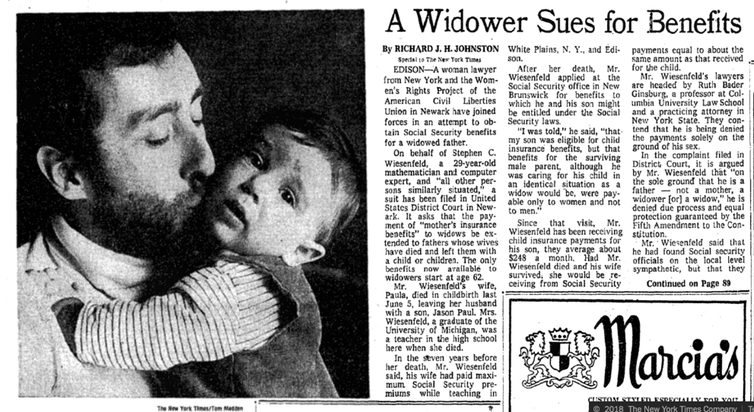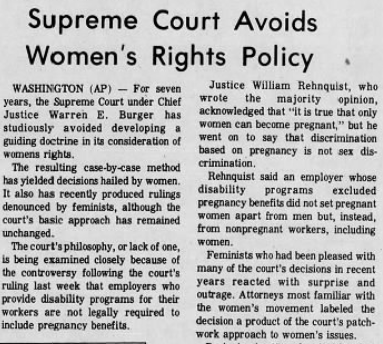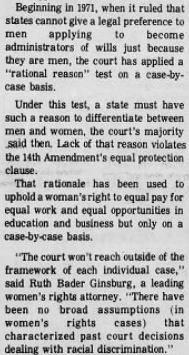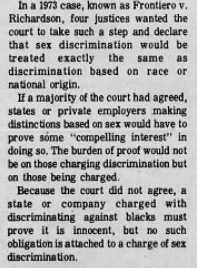
Supreme Court Justices ruling "Weidnberger v. Wiesenfeld", 1975, Oyez

The whole foundation of this ideological barrier broken lies on the context of the case, “Weinberger v. Wiesenfeld.” Argued at the Supreme Court by Ruth Bader Ginsburg on January 20th, 1975 with unanimous ruling in favor of the appellee, Stephen Charles Wiesenfeld, changed the course of gender equality.
Wiesenfeld married his wife, Paula Polatschek, who was a teacher prior to their marriage. She continued to teach after they had gotten married becoming the principle source of income. Polatschek died in childbirth leaving Wiesenfeld to care for his newborn son and support him on the low income he had. Wiesenfeld applied for social security benefits for him and his son, but was told only his son could receive them. At this time, social security benefits for widowed wives and mothers were available to both the children and the widow, whereas, for widowed husbands and fathers, social security benefits were only redeemable for the children. This law shows the blatant act of gender stereotypes by assuming a woman would never be the primary source of income for a household. Wiesenfeld sued on the claim that, “the relevant section of the Social Security Act unfairly discriminated on the basis of sex” according to Oyez.

Supreme Court Justices ruling "Weidnberger v. Wiesenfeld", 1975, Oyez

Portrayal of Ruth Bader Ginsburg in the movie "On the Basis of Sex", 2018, buzz.ie
“If my rough estimatical calculations are correct, right now, the female wage earners receive a 33% greater coverage under the Act, in terms of dollars than does male wage earner.” The lawyer for the appellant, Keith A. Jones, demonstrates the inequality of this law but contests to the fact that granting benefits to the appellee “would simply further tilt the scales in favor of the female wage earner as against her male counter part.”
This point was disproved when Ruth Bader Ginsburg presented the case for her appellee, “A child in care benefit for survivors of a female insured worker is absolutely excluded even though as here the deceased mother was the family's principle bread winner. This absolute exclusion, based on gender per se, operates to the disadvantage of female workers, their surviving spouses and their children. It denies the female worker social insurance family coverage of the same quality as the coverage available under the account of a male worker.”

Stephen Wiesenfeld, New York Times

Stephen Wiesenfeld, 2018, Miami Film Festival
“That notion that we should each be free to develop our own talents, whatever they may be and not be held back by artificial barriers, man made barriers, certainly not Heaven-sent.” Ruth Bader Ginsburg
With the winning of this case, Ruth Bader Ginsburg broke the ideological barrier relating to sex-discrimination taking one more step closer to gender equality. This barrier fits under the ideological category for being an issue society has implemented within the culture. It’s a thought in one’s mind, a belief and in order for it to be changed and enforced it must be proven and righted by the justice system. "Weinberger v. Wiesenfeld" broke the barrier for acknowledgment of sex-discrimination by showing how the laws meant to prevent women from growing also hinder men at the same time. This case brought in a lot of publicity within newspapers and helped the spread of this idea which contributed to the breaking of the stereotype, “women are incapable of doing a man’s job.”

This newspaper is an example of the discrimination women faced within the workplace. These two cases came two and four years before Ginsburg's case. This shows what a massive breakthrough she made by showing the opinions of the Supreme Court before she fought "Weinberger v. Wiesenfeld."

It also represents the difficulty she had to face in doing so.

1976, The Kane Republican